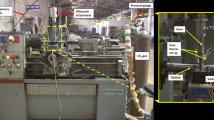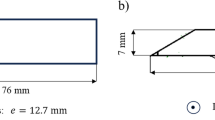Abstract
Conventional threading operations involve two distinct machining processes: drilling and threading. Therefore, it is time consuming for the tools must be changed and the workpiece has to be moved to another machine. This paper presents an analysis of the combined process (drilling followed by threading) using a single tool for both operations: the tap-milling tool. Before presenting the methodology used to evaluate this hybrid tool, the ODS (operating deflection shapes) basics is shortly described. ODS and finite element modeling (FEM) were used during this research to optimize the process aiming to achieve higher stable machining conditions and increasing the tool life. Both methods allowed the determination of the natural frequencies and displacements of the machining center and optimize the workpiece fixture system. The results showed that there is an excellent correlation between the dynamic stability of the machining center-tool holder and the tool life, avoiding a tool premature catastrophic failure. Nevertheless, evidence showed that the tool is very sensitive to work conditions. Undoubtedly, the use of ODS and FEM eliminate empiric decisions concerning the optimization of machining conditions and increase drastically the tool life. After the ODS and FEM studies, it was possible to optimize the process and work material fixture system and machine more than 30,000 threaded holes without reaching the tool life limit and catastrophic fail.
Similar content being viewed by others
References
Ertunc HM, Oysu C (2004) Drill wear monitoring using cutting force signals. Mechatronics 14:533–548 doi:10.1016/j.mechatronics.2003.10.005
Furness RJ, Tsao T-C, Rankin JS II, Muth MJ, Manes KW (1999) Torque control for a form tool drilling operation. IEEE Trans Contr Syst Technol 7(1):22–30 doi:10.1109/87.736745
Jantunen E (2002) A summary of methods applied to tool condition monitoring in drilling. Int J Mach Tools Manuf 42:997–1010 doi:10.1016/S0890-6955(02)00040-8
Richardson MH (1997) Is It a mode shape, or an operating deflection shape? Sound & Vibration Magazine 30th Anniversary Issue
Pai PF, Young LG (2001) Damage detection of beams using operational deflection shapes. Int J Solids Struct 38:3161–3192 doi:10.1016/S0020-7683(00)00274-2
Waldron K, Ghoshal A, Schulz MJ, Sundaresan MJ, Ferguson F, Pai PF et al (2002) Damage detection using finite element and laser operational deflection shapes. Finite Elem Anal Des 38:193–226 doi:10.1016/S0168-874X(01)00061-0
Margolis D, Shim T (2001) A bond graph model incorporating sensors, actuators, and vehicle dynamics for developing controllers for vehicle safety. J Franklin Inst 338:21–34 doi:10.1016/S0016-0032(00)00068-5
Parloo E, Verboven P, Guillaume P, Van Overmeire M (2002) Sensitivity-based operational mode shape normalization. Mech Syst Signal Process 16(5):757–767 doi:10.1006/mssp.2002.1498
Han S, Feeny B (2003) Application of proper orthogonal decomposition to structural vibration analysis. Mech Syst Signal Process 17(5):989–1001 doi:10.1006/mssp.2002.1570
Saturnino LJM (2004) Desenvolvimento de Ferramentas para Definição, Análise e Avaliação de Desempenho de Veículos Automotivos. PUC Minas, Belo Horizonte MSc. Thesis, (in Portuguese)
Gurgel AG (2006) Utilização de Métodos Numéricos e Técnicas de Monitoração do Processo de Furo-Rosqueamento na Usinagem de uma liga Al-Si-Cu. PUC Minas, Belo Horizonte MSc. Thesis, (in Portuguese)
Gurgel AG, Becker M, Landre J Jr, Sales WF Drill-threading process performance when machining AISI Al-Si-Cu4 Alloy. In: Proceedings of COBEM 2007—19th Brazilian Conference on Mechanical Engineering
Author information
Authors and Affiliations
Corresponding author
Rights and permissions
About this article
Cite this article
Sales, W.F., Becker, M., Gurgel, A.G. et al. Dynamic behavior analysis of drill-threading process when machining AISI Al-Si-Cu4 alloy. Int J Adv Manuf Technol 42, 873–882 (2009). https://doi.org/10.1007/s00170-008-1658-3
Received:
Accepted:
Published:
Issue Date:
DOI: https://doi.org/10.1007/s00170-008-1658-3




